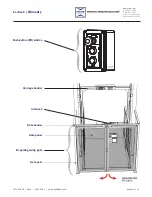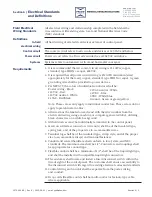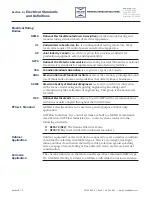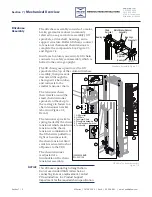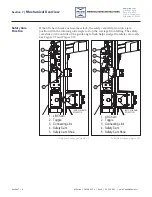
06HULHV__5HY&__HPDLOSVG#SÁRZFRP
6HFWLRQ_
Section 8 |
Electrical Overview
www.pflow.com
P 414 352 9000
F 414 352 9002
6720 N. Teutonia Ave.
Milwaukee, WI 53209
All electrical devices are connected
individually to the main control panel.
The main control panel contains a fused
transformer, motor starter, relays, etc.
A motor overload and current sensor
is provided to protect the motor from
excessive current draw.
One station is normally supplied for
each level. ASME B20.1 code requires
that the push-button stations be
remotely located and unable to be
activated by someone standing on the
carriage. Each push-button station
contains Send to “x” push-buttons and
an emergency stop (E-stop).
The Send to “x” push-buttons are
momentary contact. This means the
operator can press and release the
Send to “x” push-button and the carriage
will travel to the selected level. The
operator does not need to hold the
Send to “x” push-button for the carriage
to continue moving. When pressed, the emergency stop prevents the carriage
from moving. The emergency stop must be pulled out before carriage movement
can be initiated again.
As required by NEC code, the main disconnect switch must be fused, lockable,
and located within line of sight of the control panel and no more than 6' 6"
(1981mm) off the floor.
1
3
2
9
10
8
7
4
6
15690-0008-S.SMG
PFL-1099-4
1
3
2
9
10
8
7
4
6
1. Drivebase Assembly
2. Second Level
Push-button Station
3. Overtravel Limit Switch
4. Second Level Limit Switch
5. Disconnect Switch
6. First Level
Push-button Station
7. Main Control Panel
8. First Level Limit Switch
9. Columns
10. Carriage
55
Electrical Components Figure 8-1
The following is a standard description of the electrical wiring of an M series
VRC. This does not include any specifics on options available or ordered (e.g.,
gates, DeckLocks, photo eyes) A copy of the electrical schematic can be found in
the control panel and the shipping packet originally included in the parts crate.
Falling hazard! Make sure all safety devices are in place and operable before using
the equipment. If any safety device is missing or inoperable, immediately remove the
equipment from service.
Per ASME B20, all gates or doors accessing the lift area must be electro-mechanically
interlocked. This requires electrical contacts to prevent the lift from operating if a gate
is open when the carriage is at the level and mechanical locks to lock the gate until the
carriage is at that level.
Different gate interlock types and styles are supplied depending upon the gate type and
site conditions. Standard gate styles can incorporate one to four electrical components
per gate.
Electrical
Overview
Main Control
Panel
Push-button
Stations
Main Disconnect
Switch
NOTE

